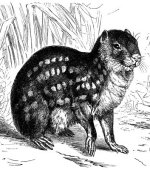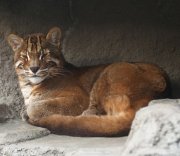Thursday 22 November 2007
Paca

The
Paca (
Agouti paca) is a solitary, nocturnal animal which can be found from Mexico to Paraguay. It lives in the rainforests near water and can dig burrows that can be two meters in length, with usually one exit, and Pacas have usually more than one burrow. To escape danger, Pacas usually flee to the water, they are good swimmers. Pacas have three to five spots on the sides of their bodies and can weigh between 6 and 12 kilos. They use their urine and anal glands to mark their territories. The Paca is considered a pest by the formers as they eat their food crops like yams, cassavas, sugar canes and corns. While they are not endangered, their numbers decline due to habitat destruction and hunting.
You can help spreading the word about this animal by liking it on facebook
Permanent Link
Tuesday 13 November 2007
Asian Golden Cat

The
Asian Golden Cat (
Catopuma temminckii) can be found scattered all over Southeast Asia, particularly, in deciduous forests, rain forests, and open terrain with rocky areas.
A typical Asian Golden Cat weighs about 8 to 15 kg. Its fur is coarse and thick, and the markings on their fur are not uniform. It changes from one location to the next, the fur's colors could be bright brown, red or gray-brown. Tail's ventral surface is principally white, and experts think that these could be used for signaling purposes.
Mating/breeding of the Asian Golden Cats occurs in hollow trees, hollows in the ground or among rocks. An Asian Golden Cat's gestation lasts up to around 95 days, and a set of 1 to 2 kittens is expected. The newborns' weight would be doubled after three weeks and tripled after six weeks. The male helps in raising the newborns.
They are mostly active during the night and they hunt hares, deer, lizards, birds and other kinds of smaller animals.
The total population of this species in the wild is unknown but it is thought to be uncommon. It has been rarely seen in the wild, although over the 1990s a few camera trap photos have been collected and two golden cats were radio-collared in Thailand’s Phu Khieu National Park
(source IUCN).
Their main threat is the loss of their natural habitat through deforestation. They are also hunted for their pelt, and the bones are used in certain medicinal mixes.
Interesting fact: Local Thai people strongly believe that when a tiger is near, burning the fur of this cat would surely help. It would cause the tiger to flee.
You can help spreading the word about this animal by liking it on facebook
Permanent Link
Friday 09 November 2007
Agile gibbon

The
Agile Gibbon (
Hylobates agilis) is a largely arboreal gibbon living in South-east Asia, in Indonesia, Thailand and Malaysia. With their long arms they can swing from branch to branch very fast and hardly every come to the ground (they can cover a distance of 10 meters from branch to branch !). Gibbon pairs are monogamous, mated pairs stick together until one mate dies. Agile gibbons defend their territory by 'singing'. In the morning, loud songs can be heard throughout the forest. Their diet consists mainly of fruit and is supplemented by insects, leaves and flowers. Their natural predators are snakes and raptors. Because the agile gibbons prefer the upper canopy, they are difficult for other predators to catch. Their main threats are habitat destruction and poaching for meat and the pet trade.
Interesting fact: Gibbons have no tails.
Picture of the Agile Gibbon by Alessio Marrucci, licensed under GFDL
You can help spreading the word about this animal by liking it on facebook
Permanent Link
 The Paca (Agouti paca) is a solitary, nocturnal animal which can be found from Mexico to Paraguay. It lives in the rainforests near water and can dig burrows that can be two meters in length, with usually one exit, and Pacas have usually more than one burrow. To escape danger, Pacas usually flee to the water, they are good swimmers. Pacas have three to five spots on the sides of their bodies and can weigh between 6 and 12 kilos. They use their urine and anal glands to mark their territories. The Paca is considered a pest by the formers as they eat their food crops like yams, cassavas, sugar canes and corns. While they are not endangered, their numbers decline due to habitat destruction and hunting.
You can help spreading the word about this animal by liking it on facebook
The Paca (Agouti paca) is a solitary, nocturnal animal which can be found from Mexico to Paraguay. It lives in the rainforests near water and can dig burrows that can be two meters in length, with usually one exit, and Pacas have usually more than one burrow. To escape danger, Pacas usually flee to the water, they are good swimmers. Pacas have three to five spots on the sides of their bodies and can weigh between 6 and 12 kilos. They use their urine and anal glands to mark their territories. The Paca is considered a pest by the formers as they eat their food crops like yams, cassavas, sugar canes and corns. While they are not endangered, their numbers decline due to habitat destruction and hunting.
You can help spreading the word about this animal by liking it on facebook 
 The
The  The
The